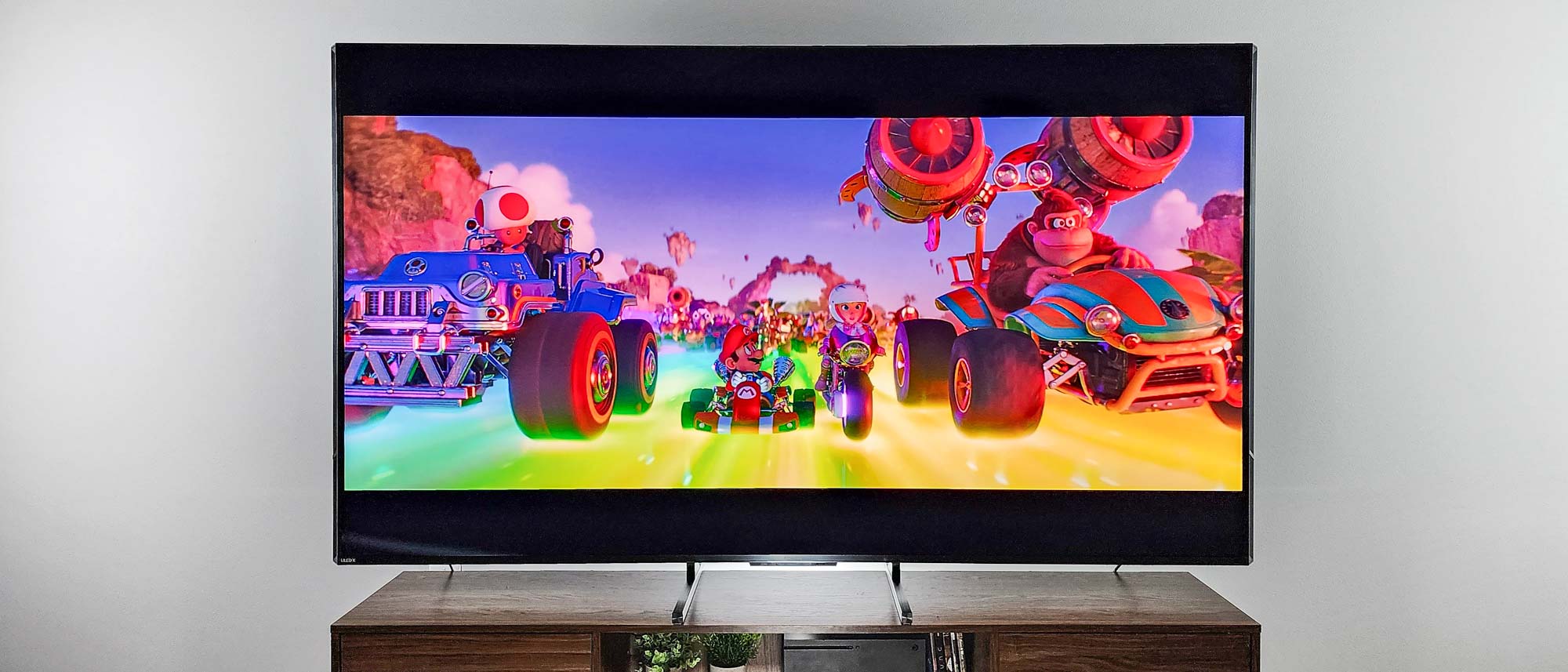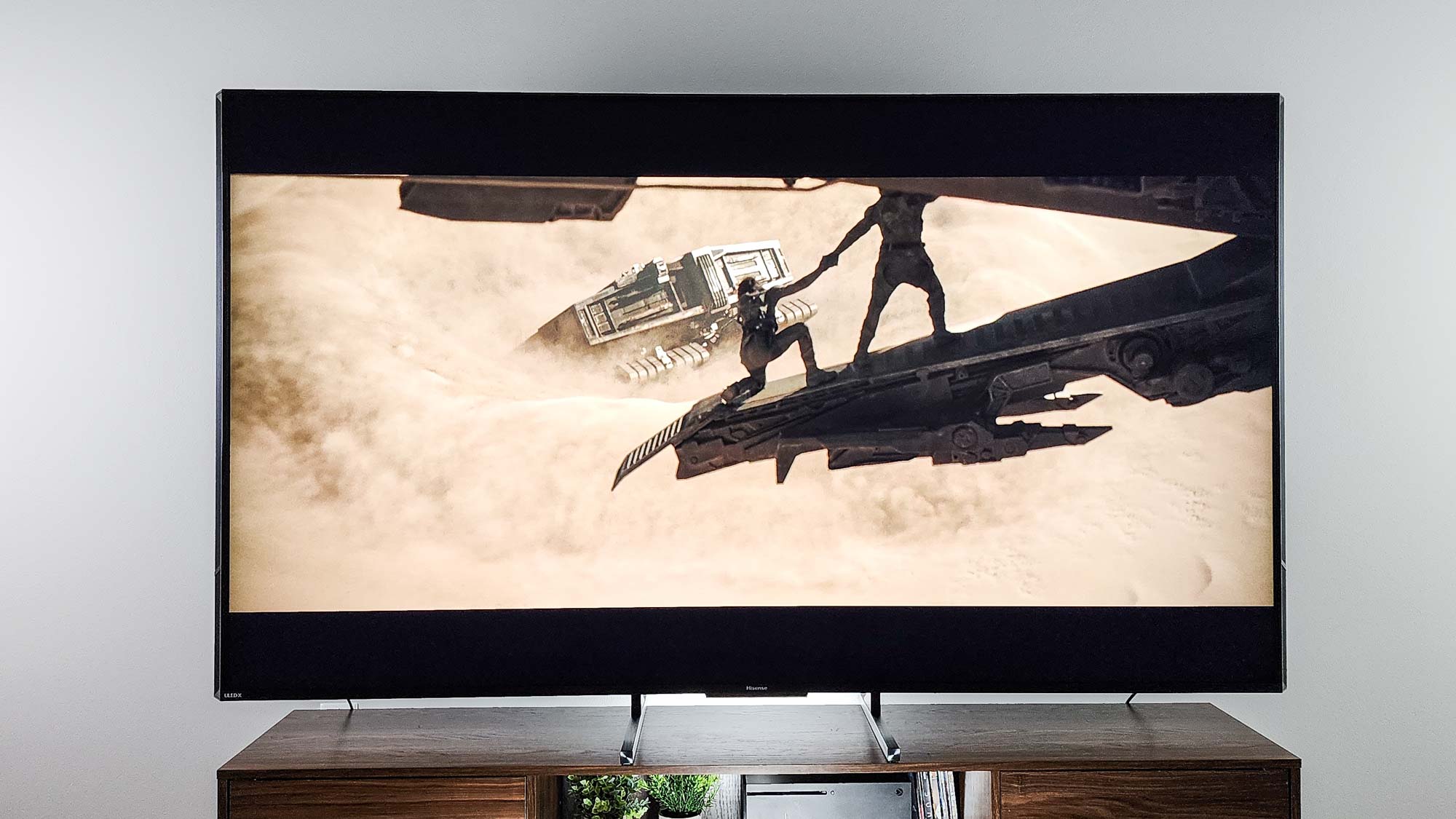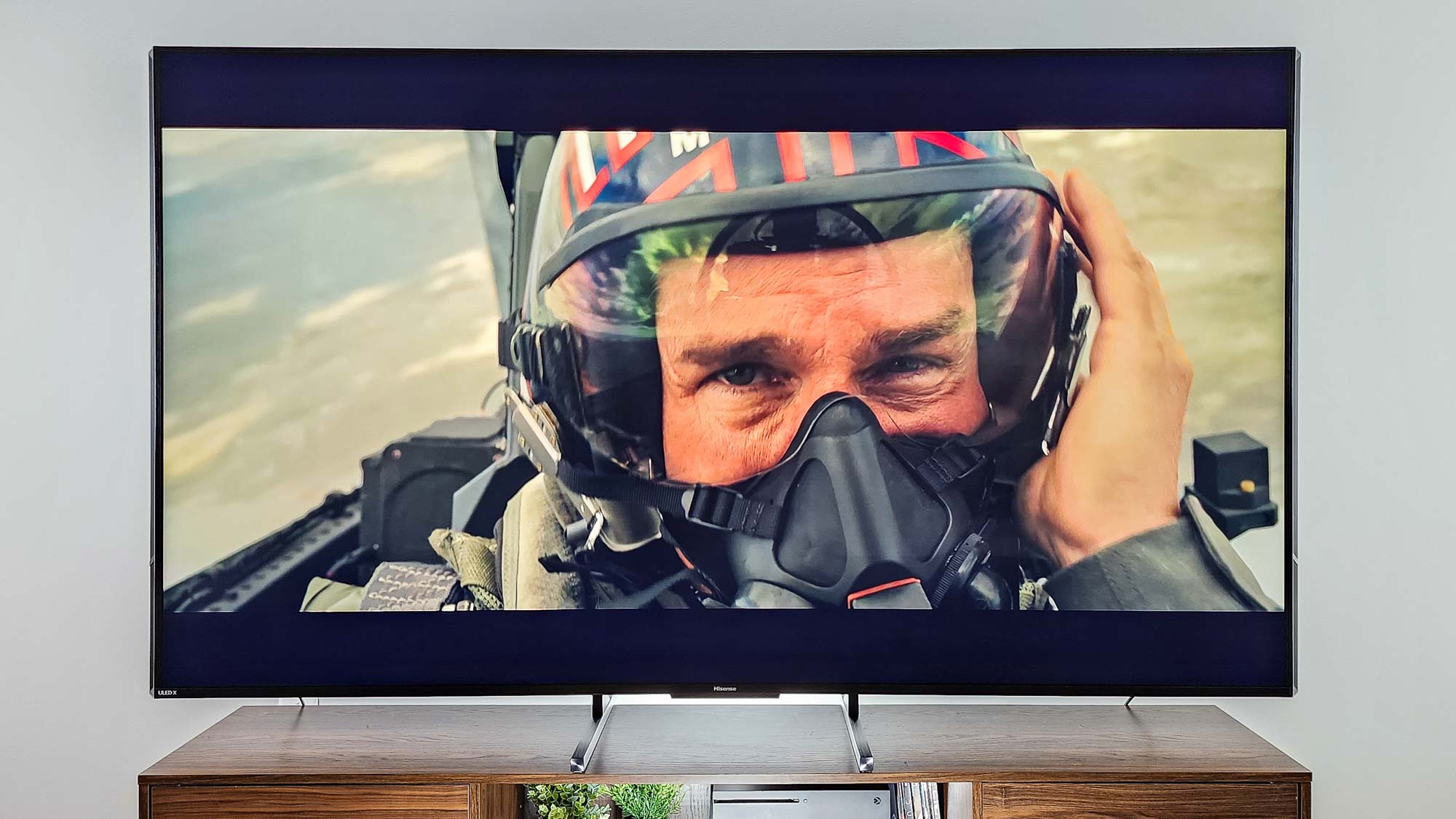Tom's Guide Verdict
The Hisense UX blazes new trails with a picture that’s brighter than any other TV we’ve seen. You also get excellent viewing angles and impressive sound from this huge 85-inch Mini-LED TV. However, the color accuracy could be better for such a high-priced set.
Pros
- +
Unparalleled brightness
- +
Terrific sound for a TV
- +
Superb viewing angles
- +
Equipped with ATSC 3.0 tuner
Cons
- -
Colors aren’t as precise as they could be
- -
Only two HDMI 2.1 ports
- -
Limited gaming capabilities
Why you can trust Tom's Guide
Price: $4,999.99
Screen size: 85 inches
Model: 85UX
Resolution: 3,840x2,160
HDR: HDR10, HDR10+, HLG, Dolby Vision
Refresh Rate: 120 Hz
Ports: 2 HDMI 2.0, 2 HDMI 2.1, 2 USB
Audio: 82W
Smart TV Software: Google TV
Size (without stand): 76.7x43.1x1.7 inches
Weight (without stand): 111.9 lbs.
If you need a TV that can light up the room literally as well as figuratively, look no further than the Hisense UX. Hisense has loaded this 85-inch QLED with technologies that will make the picture look like it’s burning off the screen. This is the brightest set we’ve ever measured, and the competition is still several (ahem) light-years behind it.
Other highlights of the Hisense UX include extra-wide viewing angles and a robust sound system. However, UX is lacking in a few other areas you might not expect. Its color accuracy isn’t as strong as we hoped, and its gaming performance and feature set could be better for a TV that costs about $5,000.
That brightness is a dazzling accomplishment, though, and it makes a compelling case for the UX as one of the best TVs of 2023 if you have the money — and a room big enough to properly house it.
Hisense UX review: Pricing and availability
The Hisense UX is part of the Hisense 2023 TV lineup and currently sits as the flagship model. Being Hisense’s highest-end TV, the UX comes in only one size: 85 inches. Its list price is $4,999.99, but as of this writing, it’s available at some online retailers for $4,499.99.
Hisense UX review: Design
The UX certainly looks the part of a top-tier TV. Whereas many sets these days are going intentionally slim, the UX doesn’t even bother: Rather than a squared-off screen, the left and right edges extend out another 0.75 inch to accommodate the two of the TV’s speakers. (See the “Audio” section for more information.) The outermost rims on both the sides and the bottom are especially shiny metal, to add just a touch of additional glint to your entertainment setup, and this line is mirrored on an additional diagonal line visible on both the left and the right.
The chief additional design element is the bezel around the screen, which measures about 0.3 inches on the left and right, roughly 0.2 inches on the top, and 0.6 inches on the bottom. The last is to accommodate the Hisense logo in the center and, below it, the IR emitter that also houses the far-field microphone switch and a hardware button that lets you change your input source, find your remote (by causing it to emit a sound), or shut off the TV’s power.
If you choose to mount your TV on the wall, you may do so with the 600x400mm VESA holes on the uncommonly elaborate rear panel, which is also loaded with ridged plastic panels, vents, and the visible subwoofer. To place the TV on an entertainment center or similar supporter, you’ll need to install the two-piece stand, which is a simple, black brushed-metal affair. (The stand is nearly 18 inches deep, so plot out the positioning accordingly.)
Get instant access to breaking news, the hottest reviews, great deals and helpful tips.

It’s worth remembering that the UX — being an 85-inch set, after all — is huge and heavy. Measuring 76.7x43.1x1.7 inches and weighing 111.9 pounds without the stand, you won’t be able to move or install it yourself unless you happen to be Bruce Banner on a really bad day. The packaging facilitates this — the box opens horizontally rather than vertically, so the set and all its packing materials can slide out the side instead of the top — but you’ll need plenty of room to do that, as well, so planning ahead is a must.
One final note: The TV’s immense size also means its 4K picture will be compromised if you view it from too close. As we said in our What size TV should you buy guide, we recommend placing it between 8.5 and 12 feet from where you plan to view it to maximize the quality of its visuals. If you can’t accommodate that, you’ll probably be better off choosing a smaller set.
Hisense UX review: Ports
The power cable connects to a port on the rear-right side of the TV, but all of the other ports face out the left edge. These include LAN, coaxial, two USB (one 2.0 carrying 0.5A of power, one 3.0 carrying 1A), a service jack, S/PDIF optical audio out, A/V in, a headphone jack, a reset button, and four HDMI ports.
Of these, only two support the newer and more powerful HDMI 2.1 standard, which allows features such as 4K at 120Hz, Variable Refresh Rate (VRR), and Auto Low-Latency Mode (ALLM) — and one of those doubles as the eARC port, so you’ll lose another 2.1 port if you hook up a soundbar. The other two (HDMI 2.0) ports max out at 60Hz. From talking to insiders in the industry, we’re aware of the viewpoint that most people won’t have more than two HDMI 2.1 devices (if that many). But we’d like to see a TV that costs upwards of $5,000 be a little more future-proof.
Hisense UX review: Performance and Test Results
For many people, OLED sets — with their perfect blacks and thus infinite contrast — are the Platonic ideal of TVs, and there’s no question they almost invariably look terrific. But if the UX doesn’t quite match them in extravagance of picture, it comes shockingly close. Hisense touts the UX’s more than 20,000 Mini LEDs and more than 5,000 local dimming zones as contributing to the set’s brightness and picture control, and this combination (what Hisense calls Mini-LED X) absolutely makes a difference in what appears on screen.
| Row 0 - Cell 0 | Hisense UX | Hisense U8K | Samsung QN90C | Samsung QN900C | TCL QM8 |
| SDR Brightness (10%, in nits) | 2,320 | 1,537 | 225.8566 | 340 | 1,348 |
| Delta-E (lower is better) | 3.784 | 4.461 | 2.240 | 2.869 | 3.232 |
| Rec. 709 Gamut Coverage | 99.9109 | 97.5132 | 99.1894 | 99.1307 | 97.5132 |
| HDR Brightness (10%, in nits) | 3,146 | 2,201 | 1,987 | 2,433 | 2,201 |
| UHDA-P3 Gamut Coverage | 98.36 | 97.26 | 94.13 | 93.04 | 97.26 |
| Rec. 2020 Gamut Coverage | 80.39 | 74.66 | 73.33 | 69.53 | 74.66 |
| Input Lag (ms) | 16 | 13 | 9.7 | 9.6 | 13 |
If we didn’t see completely flawless blacks, what we observed was nonetheless excellent, with towering contrast and minimal ghosting. The Batman, which is as dependent on the interplay between dark and darker, limned plenty of detail from shadowy visual elements such as Batman’s cowl, even when set against nighttime backdrops. Other movies, such as Denis Villeneuve’s Dune, where silhouetted figures and suffocatingly lightless interiors are key to the eerie visual texture, benefited as well.
But the eye-blasting brightness elevated everything it touched, whether action flicks like Top Gun: Maverick and Mission Impossible: Dead Reckoning Part One, the fully animated and hypersaturated The Super Mario Bros. Movie, the fusion film Avatar: The Way of Water, or the Great British Baking Show on Netflix (don’t judge me). The UX supports every major HDR technology for maximum compatibility, and unlike many non-OLED TVs, it has strikingly wide viewing angles that keep the colors bright and crisp when viewed from just about anywhere in the necessarily cavernous room. You have to stand right at a corner for the center of the screen to start dulling, and even then, the change is almost imperceptible.
We confirmed all this with our technical tests, conducted with an X-Rite i1 Pro spectrophotometer, a SpectraCal VideoForge Pro pattern generator, and Calman TV calibration software, measuring (in Filmmaker Mode, the closest to an out-of-the-box-calibrated experience) some truly unprecedented brightness numbers: 2,321 nits with SDR content and 3,165 nits (in a 10% window) with HDR — nothing else has ever come close, with any panel technology.
The Hisense UX delivered some truly unprecedented brightness numbers: 2,321 nits with SDR content and 3,165 nits with HDR — nothing else has ever come close, with any panel technology.
Because humans experience brightness logarithmically, you may not always be able to tell the difference between two TVs of different brightness levels — but the UX is substantial enough that you almost certainly will. The UX even maintains its industry-leading brightness up to 100% of the picture, where we still measured 834 nits. (Everything at and above 50% is more competitive, but the UX is amazingly bright on any amount of the screen.)
Unfortunately, the color wasn’t quite as pleasing. The rich underwater hues that are so elemental to The Way of Water took on a slightly polluted green edge that undercut their intended softness, and The Super Mario Bros. Movie looked a trifle more oppressively colorful than it should. In addition, just about all skin tones were marginally, but noticeably, too rosy. This is one case where the brightness, further accentuating even the most minute of missteps, doesn’t help.
Our testing revealed the reason for this, too: relatively low color accuracy. The UX’s Delta-E rating (which rates the difference between the picture at the source and on the screen, with lower numbers being better) of 3.7842 isn’t great and its coverage of 99.5992% of the Rec. 709 (SDR) color gamut can’t make up for it. By comparison, the LG G3 OLED was able to cover 99.7631% of the same color space with a significantly lower Delta E rating of 1.8611.
The UX handles HDR color better, covering 98.32% of the UHDA-P3 gamut and 80.39% of BT.2020, placing it in front of its direct competition (if generally behind OLED sets), but that can’t make up for the accuracy.
This is, of course, something you can address via calibration, whether you perform it yourself or hire a professional to do it for you. But when a TV costs this much — and especially when other manufacturers can do this better up front — should you have to?
Hisense UX review: Audio
Even the best-looking TVs on the market can sound substandard, but that’s not a problem the UX faces. Boasting a seven-speaker (4.1.2-channel) audio setup, which includes that subwoofer; 82 watts of power; and support for both Dolby Atmos and IMAX Enhanced, the UX is one of the most satisfying-sounding TVs you can find.
Okay, so its bass response isn’t superb. In the opening section of The Knife’s “Silent Shout,” it stopped short of rattling the walls or my ribcage. But it demonstrated astonishing clarity up to the set’s highest volume levels. The same was true of my soprano musical test track, which climaxes on a high B-flat — a beautiful, clarion sound without a touch of the shrillness that frequently creeps in when many TVs are at their loudest. Top Gun: Maverick and Dead Reckoning, which feature traditional “action movie” soundtracks that layer speech, music, and complicated sound effects, played thoroughly naturally as well.
Although you could augment the UX with one of our best soundbars, unless you’re a die-hard audiophile, you probably won’t feel the need to.
Hisense UX review: Gaming
For all the attention lavished on its display, gaming has not received similar amounts of love. Using a Leo Bodnar 4K Input Lag Tester, we measured the UX’s input lag at 16ms. That’s not terrible (we look for anything below 20ms), and it’s on par with TCL’s 13ms, but it’s not in the realm of sub-10ms times we’ve seen from other top-tier TVs like the Samsung QN90C (9.7ms).
Though there are, as mentioned, only two HDMI 2.1 ports, those do give you access to the full range of gaming features most players today would expect: 4K at 120Hz, VRR, and ALLM. The UX also supports AMD FreeSync Premium Pro, which is designed to eliminate screen tearing even in titles running in HDR. But you won’t find the Game Bar, which we saw on Hisense’s U7K and U8K. This adds a lot of easy-access functionality to game playing, and is a notable omission on any set in this price range.

Both Assassin’s Creed Valhalla and Starfield looked good and played smoothly on the UX with our Xbox Series X, but the same caveats apply that do with any other content: You’ll want to sit a good distance away, because even those games’ beautiful Nordic and intergalactic vistas look mighty blocky when seen up close on an 85-inch TV.
Hisense UX review: Smart features
Like all of Hisense’s newer TVs, the UX sports the excellent Google TV smart interface. In addition to plugging you into the full breadth of Google’s search and smart-home ecosystems, it’s also just a pleasure to use.
At the top of the screen is a navigation menu that, in addition to the default For You screen, also provides access to Live (live TV, which thanks to the UX’s ATSC 3.0 tuner can be 4K over the air); Apps; and Library, where you can store things you want to watch as you come across them in your searches. Speaking of which, the magnifying glass icon in the upper-right corner starts Google’s uber-powerful search engine (or you can use the far-field microphone or the corresponding button on the remote to conduct a voice search), and you can open the TV’s settings or your own Google Account from other choices.
The main carousel on the For You screen is excellent at surfacing interesting, relevant material. In addition to the expected Halloween options in October, the carousel promoted Dead Reckoning immediately upon its streaming release and PlutoTV’s Three’s Company reruns.
Below the carousel is Top Picks for You, which consistently drew from my interests and viewing habits. Then there’s the fully stacked Apps bar and Continue Watching. The curated collections and recommendations toward the bottom of the page are less a, though they were invariably in the neighborhood of things I might want to check out if I didn’t already have enough stacked up to watch into 2025.
If your backlog isn’t quite as hefty as mine, you can also stream from various mobile devices using Google Chromecast or Apple AirPlay. There’s also the expected smart-home integration by way of Amazon Alexa, in addition to the expected Google Assistant.
Hisense UX review: Remote control
My favorite feature of Hisense’s current remote control remains the flared base, which allows you to position the remote vertically to make it harder to lose and easier to grab. But it’s a fine design overall, with just the right number of buttons, smartly organized, and a color scheme (with certain key controls — including Google Assistant, the navigation wheel, and the Home button — in white) that makes it easy to use. There are six shortcut keys at the bottom, for Netflix, Amazon Prime Video, YouTube, Disney+, Tubi, and Peacock.
The buttons’ backlight activates only when you’re pressing them, and it’s not very bright, though it does aid in visibility. Any way you look at it, though, it’s a stand-up remote in more ways than one.
Hisense UX review: Verdict
There’s no doubt about it: The Hisense UX is stunning. Besides the incomparable brightness, those near-OLED blacks and ultrawide viewing angles add a lot to every second of the viewing experience. And many of the TV’s other features only sweeten the pot.
Note that I didn't want to say “deal” there because this is a $5,000 TV. And for a Mini-LED set this expensive, there’s more trade-offs than I’d like to see. This includes color accuracy that could be better out of the box and input lag that’s not ideal for gaming.
Overall, if you have the money to spend, and a living room spacious enough to do the picture justice, the Hisense UX is a captivating blend of size, price and features. If you want a cinema-sized screen, it’s a great option.
Matthew Murray is the head of testing for Future, coordinating and conducting product testing at Tom’s Guide and other Future publications. He has previously covered technology and performance arts for multiple publications, edited numerous books, and worked as a theatre critic for more than 16 years.












